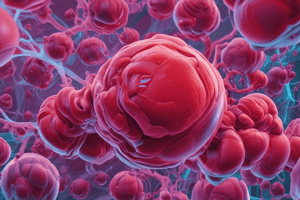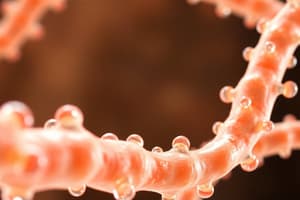Podcast
Questions and Answers
What is affected by iron status as well as PEM status?
What is affected by iron status as well as PEM status?
- Serum Transferrin (correct)
- Transthyretin (Pre-Albumin)
- Retinol-Binding Protein
- Unmentioned in the passage
Why can't Serum Transferrin be used to monitor protein status in intervention studies?
Why can't Serum Transferrin be used to monitor protein status in intervention studies?
- Because it's not a transport protein
- Because it's affected by many variables
- Because the response to dietary treatment is poor (correct)
- Because it's a positive acute-phase protein
What is the half-life of Transthyretin (Pre-Albumin)?
What is the half-life of Transthyretin (Pre-Albumin)?
- 1-2 weeks
- 5-7 days
- 12 hours
- 2-3 days (correct)
What is Transthyretin (Pre-Albumin) affected by, aside from protein-energy status?
What is Transthyretin (Pre-Albumin) affected by, aside from protein-energy status?
What is the half-life of Retinol-Binding Protein?
What is the half-life of Retinol-Binding Protein?
What is Retinol-Binding Protein sensitive to?
What is Retinol-Binding Protein sensitive to?
When is Serum Transferrin high?
When is Serum Transferrin high?
What is decreased with Zinc deficiency?
What is decreased with Zinc deficiency?
What is the formula for nitrogen balance?
What is the formula for nitrogen balance?
What is the nitrogen balance in healthy adults?
What is the nitrogen balance in healthy adults?
Who would have a positive nitrogen balance?
Who would have a positive nitrogen balance?
What is the half-life of C-Reactive Protein (CRP)?
What is the half-life of C-Reactive Protein (CRP)?
What is the normal range of C-Reactive Protein (CRP)?
What is the normal range of C-Reactive Protein (CRP)?
What is a common cause of nutritional anemia?
What is a common cause of nutritional anemia?
What type of anemia is caused by iron deficiency?
What type of anemia is caused by iron deficiency?
What is the conversion factor to calculate nitrogen intake from protein intake?
What is the conversion factor to calculate nitrogen intake from protein intake?
What is the main limitation of using serum total protein as an index for protein status?
What is the main limitation of using serum total protein as an index for protein status?
What is the function of serum albumin in the body?
What is the function of serum albumin in the body?
What is the half-life of serum albumin?
What is the half-life of serum albumin?
What is a confounding factor that can affect serum albumin levels?
What is a confounding factor that can affect serum albumin levels?
What is the characteristic of serum albumin levels in Kwashiorkor patients?
What is the characteristic of serum albumin levels in Kwashiorkor patients?
What is the function of serum transferrin in the body?
What is the function of serum transferrin in the body?
What is the half-life of serum transferrin?
What is the half-life of serum transferrin?
What is the characteristic of serum albumin levels in Marasmus patients?
What is the characteristic of serum albumin levels in Marasmus patients?
What is Microcytic anemia associated with?
What is Microcytic anemia associated with?
What does a low Mean Cell Volume (MCV) indicate?
What does a low Mean Cell Volume (MCV) indicate?
What is the meaning of MCHC?
What is the meaning of MCHC?
What type of anemia is characterized by large, immature RBC?
What type of anemia is characterized by large, immature RBC?
What is the classification of anemia based on?
What is the classification of anemia based on?
What is the significance of MCV in anemia diagnosis?
What is the significance of MCV in anemia diagnosis?
What is Megaloblastic anemia related to?
What is Megaloblastic anemia related to?
What is the characteristic of MCHC in iron deficiency anemia?
What is the characteristic of MCHC in iron deficiency anemia?
What is the classification of anemia based on cell size?
What is the classification of anemia based on cell size?
What is the function of transferrin in the body?
What is the function of transferrin in the body?
What percentage of body iron is stored in ferritin?
What percentage of body iron is stored in ferritin?
What is the main site of storage iron?
What is the main site of storage iron?
What is the limitation of using hemoglobin as a test for iron deficiency anemia?
What is the limitation of using hemoglobin as a test for iron deficiency anemia?
What is hematocrit?
What is hematocrit?
What is the percentage of iron in hemoglobin?
What is the percentage of iron in hemoglobin?
What is the effect of iron deficiency on hemoglobin?
What is the effect of iron deficiency on hemoglobin?
Flashcards are hidden until you start studying
Study Notes
Visceral Protein Status
- Serum total protein is maintained within a normal range, and significant depletion appears when clinical signs are presented.
- It is easy to measure but not a sensitive index for protein status (half-life 14-20 days).
Serum Albumin
- Classical test for assessing protein status.
- Not very sensitive for short-term changes.
- Low level of albumin indicates prolonged protein deficiency.
- Abundant in serum and stable (half-life 3 weeks).
- Maintains colloidal oncotic pressure and is a transport protein.
- Affected by other confounding factors:
- Low: gastrointestinal disorder, renal diseases, liver failure, and decreased synthesis with age.
- High: semi-starvation state and dehydration (blood volume).
- In Kwashiorkor, low albumin level is used to define children susceptible to edema.
- In Marasmus, weight for age is used because no change in albumin levels is present.
Serum Transferrin
- Synthesized exclusively in the liver and serves as an iron transport protein.
- Half-life: 8-10 days (negative acute phase respondent).
- Affected by iron status as well as PEM status.
- Low: renal, liver, gastrointestinal tract diseases, and cases when requirements for iron transport are reduced (iron overload), chronic, and infections.
- High: in iron deficiency anemia in response to increased iron absorption and pregnancy.
- Response to dietary treatment is poor.
Transthyretin (Pre-Albumin)
- Transport protein for thyroxine and the carrier for retinol-binding protein.
- Half-life: 2-3 days (negative acute phase reactant).
- More sensitive than serum albumin and transferrin in monitoring improvements in protein-energy status if baseline value is obtained.
- Affected by other confounding factors:
- Gastrointestinal diseases, renal diseases, trauma, stress, infections, etc.
- Decreased with: Zinc deficiency.
- Increased with: Corticosteroid use and renal failure.
Retinol-Binding Protein
- Carrier protein of retinol.
- Half-life: 12 hours (negative acute-phase protein).
- Sensitive to protein status but less sensitive to energy status.
- Responds rapidly to dietary treatment.
Nitrogen Balance
- Nitrogen balance = nitrogen intake (g/24 hours) – urinary nitrogen (blood urea nitrogen) (g/24 hours) + 2 (g/24 hours).
- Use correction of 4 (g/24 hours) if urinary urea nitrogen is used.
- Nitrogen intake = protein (grams /24 hours) / 6.25.
- Nitrogen balance in healthy adults is 0.
- Nitrogen balance is positive in growing children, pregnant women, adults gaining weight or recovering from illness or injury.
- Nitrogen balance is negative during starvation, catabolism, and PEM.
Acute Phase Protein
- C-Reactive Protein (CRP):
- Synthesized in liver.
- t1/2 = 5-7 hours.
- Normal: < 0.8 mg/dl.
- Positive acute phase protein.
- May increase with 4-6 hours of stress.
- Inflammation; trauma.
- Decreases when stress subsides.
Assessment of Nutritional Anemia
- Common causes of nutritional anemia:
- Low intake of iron and folate.
- Low intake of heme-iron (available iron).
- Increased requirements.
- Increased losses due to infections.
- B-12 deficiency.
- Types of Anemia:
- Normocytic Normochromic: anemia of chronic diseases.
- Microcytic Hypochromic: iron deficiency anemia.
- Macrocytic Normochromic: folate or B12 deficiency anemia.
- Based on cell size:
- Macrocytic (large).
- Normocytic (normal).
- Microcytic (small).
- Based on hemoglobin content:
- Hypochromic (pale color).
- Normochromic (normal color).
Forms of Iron in the Body
- Transferrin:
- Transport protein for iron.
- Negative acute-phase protein.
- Hemoglobin:
- 70 % in red blood cells.
- 4 % in muscle oxygen-binding protein (myoglobin).
- 1% in enzymes.
- Storage Iron:
- 25 % of body iron (ferritin).
- Mainly in the liver, spleen, and bone marrow.
- Positive acute-phase protein.
Stages of Iron Deficiency
- Iron depletion of iron stores.
- Iron deficient erythropoiesis.
- Iron deficiency anemia.
Assessment of Iron Deficiency Anemia
-
- Hemoglobin (Hb):
- Most widely used test for iron deficiency anemia.
- Limitations:
- Not a good indicator for early iron deficiency.
- Can be < normal with adequate iron and > normal with inadequate iron.
- The morning value is higher than the evening value.
-
- Hematocrit:
- Represents packed cell volume (PCV), expressed as a percent of the total blood volume.
- Easy, rapid, and used to assess iron deficiency anemia.
- Decreased after Hb formation decreased.
- Limitations:
- Not sensitive for early ID.
- Not specific because it is affected by factors and influence Hb.
-
- Mean Cell Volume (MCV):
- Volume or size of average red blood cells (PCV/RBC).
- Low MCV is a relatively specific index for iron deficiency anemia.
- Low in iron deficiency anemia.
- High in B12 and folate anemia.
-
- Mean Cell Hemoglobin (MCH):
- Amount of Hb in RBC’s (Hb/RBC).
-
- Mean Cell Hemoglobin Concentration (MCHC):
- Concentration of Hb in RBC (color of the cell).
- Least useful because it is the last to fall in iron deficiency anemia.
Classification of Anemia
- Microcytic anemia:
- Inability to absorb, transport, store, or utilize iron.
- Also, from deficiencies in protein, vitamin A, pyridoxine, copper, manganese.
- Megaloblastic anemia:
- Large, immature RBC.
- May be related to folate and/or vitamin B12 deficiency.
- Pernicious anemia.
Classification of Anemia by Complete Blood Count (CBC)
- MCV:
- Decreased in iron deficiency anemia.
- Increased in folate and B12 deficiency.
Studying That Suits You
Use AI to generate personalized quizzes and flashcards to suit your learning preferences.




